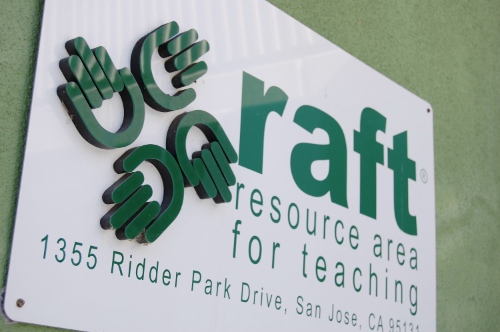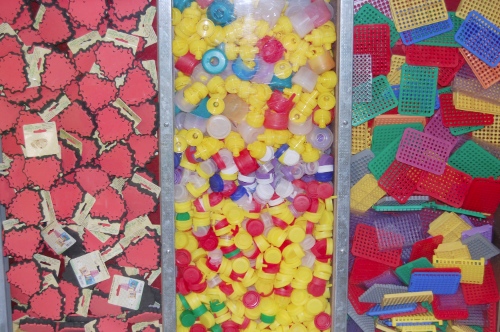“What would teacher heaven would look like?" That’s the question that inspired the Resource Area For Teaching, says its founder and Executive Director Mary Simon.
The veteran educator then built it.
Simon’s vision of teacher heaven, popularly known as RAFT, is several things. It’s a certified-green, Bay Area-based non-profit that collects surplus business materials and turns them into learning kits. It’s a distributor of classroom materials. It’s a provider of resources and workshops to teachers, and it’s a work area filled with tools such as laminating machines, giant paper cutters, die-cut tools, and the like.

However, to see RAFT as a one-stop teacher shop is to miss the mark. It would be more accurate to think of RAFT as a game-changing model of educational innovation, based on material re-purposing, a keen awareness of how learning happens, and a profound commitment to supporting teachers—all born of one woman’s visionary idea.
“The thing that drives RAFT is the importance of inspiring children to fall in love with a particular subject,” says Simon. “That’s not going to happen if teachers don’t have novel ideas to bring into their classrooms.”
Bringing novel ideas into classrooms is the name of the game at RAFT, where there is an unwavering focus on getting hands-on learning materials in front of students. “One of the things [with today’s classrooms] is that there’s never enough material to have your own,” says Simon. “You can pass the magnets around, but they need to stay on the science table; you can’t have one, and do all the things you’d want to do with that magnet.”

Hands-on teaching has been shown to increase student motivation, comprehension and retention, and is widely accepted as best practice, which comes as no surprise to Simon. “I have a hard time thinking about what would be an interesting and engaging lesson without tangible pieces in front of me,” she says. “So I get a plethora of materials around me in order to inspire my own innovation.”
One of the obstacles to getting hands-on materials into the hands of students, is that materials cost money, and schools—you might have heard—don’t have any money to spend. This is where the brilliance of RAFT, and the sheer ingenuity of Simon’s shareable vision, comes into focus.
RAFT receives surplus materials from local businesses—think widgets, foam shapes, bottle caps, fabric scraps, cardboard tubes, etc. The materials are then sorted by a team of trained innovation experts, and turned into activity kits that introduce specific concepts such as fractions, volume, gravity, variables, the solar system and DNA, to name just a few.

The kits are then made available at low-cost to RAFT members—who range from classroom teachers and home-schoolers to after-school care providers and librarians—through RAFT warehouses, located in Sacramento, Denver and the Bay Area. In addition to the pre-made kits, the warehouses also contain enormous bins full of loose materials and supplies just waiting to be turned into classroom tools.
So, we have RAFT getting hands-on activities into schools, providing teachers with ideas and projects to enrich their classrooms, and taking materials that were destined for the landfill and re-purposing them into learning kits.
But what about Simon’s vision of teacher heaven? Providing access to low-cost, hands-on materials is a good start, but the heart of RAFT lies in the environment that it provides for educators. “I always knew that [RAFT] was going to be a place of abundance that would have everything that a teacher craved,” says Simon. “That [teachers] would be very respected and honored in this building, and inspired to remember what it was that led them to want to be a teacher.”

RAFT is a place made for teachers, by teachers. Things are bundled with clear instructions and recommended grade levels on them; there are completed examples of all the activities; there’s a knowledgeable and friendly staff to demonstrate activities and help orient new teachers, and there a sense of camaraderie and collaboration that is palpable. And, just as you would expect from a community of teachers, it’s all very tidy and neatly laid out. “It’s important to me that things look really neat and organized,” says Simon. “It could look like a garage sale, but we don’t want that. We want teachers to come into a professional place…and be treated like the professionals that they are.”
In addition to an abundance of in-house offerings, RAFT also has an outreach team that goes into classrooms to find out what teachers need. “A lot of what we do in society is decide what would be good for teachers, without asking teachers what would be good for them,” says Simon. “We asked one district what the most difficult things to teach were, and they gave us a list of the top five challenges. So, we created a series of workshops around their challenges.”
Running teacher heaven, however, is not easy or cheap, and RAFT relies heavily on volunteers, grants and donations. “It’s hard to find a Silicon Valley company that doesn’t support RAFT,” says Simon, who lists HP, National Semiconductor and Oracle among RAFT’s supporters. But, there are many more, and with good reason: Simon and her team of innovators are stoking the minds of the future through their commitment to learning.
“Kids deserve to have an interesting education, an interesting day, an inspiring day,” says Simon emphatically. “We want to fill the cup and light the flame.”









